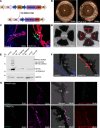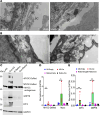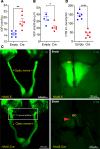Impaired axonal transport contributes to neurodegeneration in a Cre-inducible mouse model of myocilin-associated glaucoma
- PMID: 39836483
- PMCID: PMC11949003
- DOI: 10.1172/jci.insight.188710
Impaired axonal transport contributes to neurodegeneration in a Cre-inducible mouse model of myocilin-associated glaucoma
Abstract
Elevation of intraocular pressure (IOP) due to trabecular meshwork (TM) dysfunction, leading to neurodegeneration, is the pathological hallmark of primary open-angle glaucoma (POAG). Impaired axonal transport is an early and critical feature of glaucomatous neurodegeneration. However, a robust mouse model that accurately replicates these human POAG features has been lacking. We report the development and characterization of a new Cre-inducible mouse model expressing a DsRed-tagged Y437H mutant of human myocilin (Tg.CreMYOCY437H). A single intravitreal injection of HAd5-Cre induced selective MYOC expression in the TM, causing TM dysfunction, reducing the outflow facility, and progressively elevating IOP in Tg.CreMYOCY437H mice. Sustained IOP elevation resulted in significant loss of retinal ganglion cells (RGCs) and progressive axonal degeneration in Cre-induced Tg.CreMYOCY437H mice. Notably, impaired anterograde axonal transport was observed at the optic nerve head before RGC degeneration, independent of age, indicating that impaired axonal transport contributes to RGC degeneration in Tg.CreMYOCY437H mice. In contrast, axonal transport remained intact in ocular hypertensive mice injected with microbeads, despite significant RGC loss. Our findings indicate that Cre-inducible Tg.CreMYOCY437H mice replicate all glaucoma phenotypes, providing an ideal model for studying early events of TM dysfunction and neuronal loss in POAG.
Keywords: Genetics; Neurodegeneration; Neuroscience; Ophthalmology; Protein misfolding; Transport.
Conflict of interest statement
Figures








Update of
-
Impaired axonal transport at the optic nerve head contributes to neurodegeneration in a novel Cre-inducible mouse model of myocilin glaucoma.bioRxiv [Preprint]. 2024 Nov 2:2024.09.18.613712. doi: 10.1101/2024.09.18.613712. bioRxiv. 2024. Update in: JCI Insight. 2025 Jan 21;10(5):e188710. doi: 10.1172/jci.insight.188710. PMID: 39345520 Free PMC article. Updated. Preprint.
Similar articles
-
Impaired axonal transport at the optic nerve head contributes to neurodegeneration in a novel Cre-inducible mouse model of myocilin glaucoma.bioRxiv [Preprint]. 2024 Nov 2:2024.09.18.613712. doi: 10.1101/2024.09.18.613712. bioRxiv. 2024. Update in: JCI Insight. 2025 Jan 21;10(5):e188710. doi: 10.1172/jci.insight.188710. PMID: 39345520 Free PMC article. Updated. Preprint.
-
Expression of Mutant Myocilin Induces Abnormal Intracellular Accumulation of Selected Extracellular Matrix Proteins in the Trabecular Meshwork.Invest Ophthalmol Vis Sci. 2016 Nov 1;57(14):6058-6069. doi: 10.1167/iovs.16-19610. Invest Ophthalmol Vis Sci. 2016. PMID: 27820874 Free PMC article.
-
CNS axonal degeneration and transport deficits at the optic nerve head precede structural and functional loss of retinal ganglion cells in a mouse model of glaucoma.Mol Neurodegener. 2020 Aug 27;15(1):48. doi: 10.1186/s13024-020-00400-9. Mol Neurodegener. 2020. PMID: 32854767 Free PMC article.
-
Age at Glaucoma Diagnosis in Germline Myocilin Mutation Patients: Associations with Polymorphisms in Protein Stabilities.Genes (Basel). 2021 Nov 16;12(11):1802. doi: 10.3390/genes12111802. Genes (Basel). 2021. PMID: 34828408 Free PMC article. Review.
-
Targeting the ER-autophagy system in the trabecular meshwork to treat glaucoma.Exp Eye Res. 2016 Mar;144:38-45. doi: 10.1016/j.exer.2015.08.017. Epub 2015 Aug 22. Exp Eye Res. 2016. PMID: 26302411 Free PMC article. Review.
Cited by
-
Protein misfolding and mitochondrial dysfunction in glaucoma.Front Cell Dev Biol. 2025 Apr 25;13:1595121. doi: 10.3389/fcell.2025.1595121. eCollection 2025. Front Cell Dev Biol. 2025. PMID: 40385286 Free PMC article. Review.

